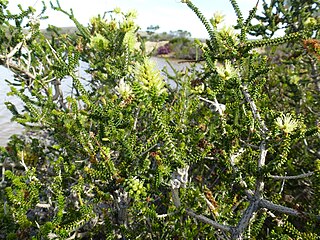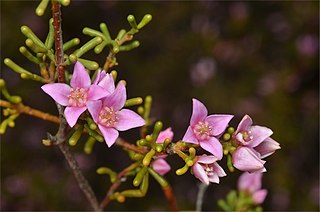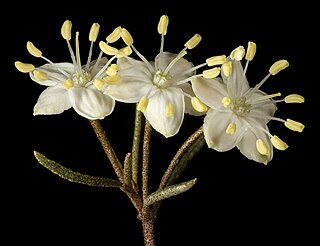Verticordia brachypoda is a flowering plant in the myrtle family, Myrtaceae and is endemic to the south-west of Western Australia. It is an irregularly branched shrub with narrow leaves crowded on side-branches, and cream-coloured or white flowers with pink, cream or white centres.
Verticordia carinata, commonly known as pea-shaped featherflower or Stirling Range featherflower, is a flowering plant in the myrtle family, Myrtaceae and is endemic to Western Australia. It is an erect, spindly shrub with small, well-spaced leaves and pink and red flowers. It is a rarely seen plant, not known between its description in 1849 and its rediscovery in 1990.

Melaleuca blaeriifolia is an erect to spreading shrub in the myrtle family, Myrtaceae and is endemic to a small area in the south-west of Western Australia. It has small leaves and small greenish-yellow flowerheads.

Melaleuca ciliosa is a small shrub in the myrtle family, Myrtaceae and is endemic to the south-west of Western Australia. It has bright or pale yellow flowers, an unusual calyx and leaves that are slightly hairy, especially around the edges.

Melaleuca concinna is a small shrub in the myrtle family Myrtaceae and is endemic to the south-west of Western Australia. Its species name translates as " neat" or "pretty" and it is distinguished by having many heads of pink flowers in late spring followed by spherical clusters of woody fruits.

Beaufortia cyrtodonta, commonly known as Stirling Range bottlebrush, is a plant in the myrtle family, Myrtaceae and is endemic to the south-west of Western Australia. It is a compact shrub with crowded leaves which appear greyish due to their covering of fine, soft hairs. It has heads of red flowers in spring and occurs in the Stirling Range district.
Verticordia densiflora var. cespitosa is a flowering plant in the myrtle family, Myrtaceae and is endemic to the south-west of Western Australia. It is a shrub with small leaves and pink, or pink and white flowers. It is one of five varieties of the species Verticordia densiflora.

Verticordia fimbrilepis, commonly known as shy featherflower, is a flowering plant in the myrtle family, Myrtaceae and is endemic to the south-west of Western Australia. It is a small, bushy shrub with one openly branched main stem at its base, small, pointed leaves and rounded groups of pink flowers near the ends of the branches.

Verticordia fimbrilepis subsp. fimbrilepis is a flowering plant in the myrtle family, Myrtaceae and is endemic to the south-west of Western Australia. It is a small bushy shrub with one openly branched main stem at its base, small, pointed leaves and rounded groups of pink flowers near the ends of the branches.
Verticordia fimbrilepis subsp. australis, commonly known as southern shy featherflower is a flowering plant in the myrtle family, Myrtaceae and is endemic to the south-west of Western Australia. It is a slender shrub with one openly branched main stem at its base, small, pointed leaves and rounded groups of pink flowers near the ends of the branches.
Verticordia huegelii var. stylosa, commonly known as variegated featherflower, is a flowering plant in the myrtle family, Myrtaceae and is endemic to the south-west of Western Australia. It is a single-stemmed shrub with its growth form depending on its surroundings. It is similar to other varieties of the species but differs in its flower colour and the form of the style and staminodes.
Verticordia multiflora is a flowering plant in the myrtle family, Myrtaceae and is endemic to the south-west of Western Australia. It is a small, openly branched shrub with small leaves and groups of scented, bright yellow flowers on the ends of the branches in spring or early summer.

Hemiphora uncinata is a flowering plant in the mint family Lamiaceae and is endemic to the south-west of Western Australia. It is an erect, spreading shrub with its branches densely covered with white, woolly hairs. Its leaves are rough and wrinkled and the flowers are tube-shaped with deep pink petals with wavy edges.

Leptospermum incanum is a species of compact shrub that is endemic to Western Australia. It has hairy young stems, elongated egg-shaped leaves on a short petiole, relatively large white or pink flowers and fruit that fall from the plant when mature.
Leptospermum nitens is a species of slender shrub that is endemic to Western Australia. It has thin, fibrous bark, narrow egg-shaped to wedge-shaped leaves, white or pink flowers on short side branches and fruit with the sepals attached but that falls from the plant shortly after the seeds reach maturity.

Boronia inornata, commonly known as desert boronia, is a plant in the citrus family, Rutaceae and is endemic to southern Australia. It is an erect shrub with three-part leaves and pink, red or white, four-petalled flowers.

Boronia oxyantha is a plant in the citrus family, Rutaceae and is endemic to a small area in the south-west of Western Australia. It is a shrub with many hairy branches, pinnate leaves and pink, four-petalled flowers that have a darker midrib.

Phebalium filifolium, commonly known as slender phebalium, is a species of upright, rounded shrub that is endemic to Western Australia. It has smooth branchlets covered with silvery scales, more or less cylindrical leaves with silvery scales on the lower side and pale to bright yellow flowers arranged in umbels of between three and eight on the ends of branchlets.

Phebalium lepidotum is a species of rounded shrub that is endemic to Western Australia. It has scaly branchlets, leathery, narrow oblong leaves and white to cream-coloured flowers arranged in umbels of between three and six on the ends of branchlets.
Phebalium microphyllum is a species of small, rounded shrub that is endemic to Western Australia. It has scaly branchlets, leathery, oblong leaves and yellow flowers arranged in umbels of three to six on the ends of branchlets.












